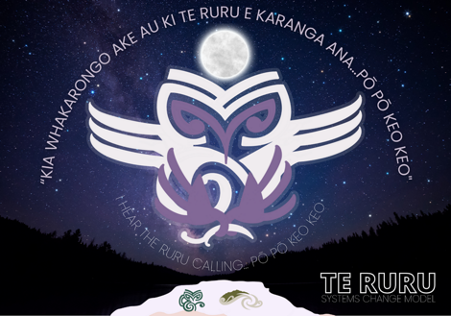Te Ruru: the creation of an indigenous systems change model in Aotearoa
You cannot change a system unless you transform consciousness. You cannot transform consciousness unless the system senses and sees itself.” - Scharmer, 2018
Moving beyond academia
Whakauae is a research services organisation, and was established to develop the research capacity of Ngāti Hauiti, a Māori iwi in Aotearoa. It undertakes high quality Māori-centred health research to inform, and contribute to, improved outcomes for Māori. Whakauae’s ultimate goal is to see a shift in Maori health inequity which supports Māori aspirations for hauora (holistic health and wellbeing).
As the recipient of a large Health Research Council grant, Whakauae wanted to push beyond the traditional boundaries of research organisations, working to create demonstrable actions by the system. Traditional approaches to sharing research saw them often ‘talking to themselves’; publishing papers and sharing with other academics at conferences that doesn’t always reach key stakeholders, funders, and communities. Stepping into systems change, Whakauae had to see themselves as part of the system and consider a new approach for breaking down traditional boundaries between research and the wider community.
Creating a model that confronts the lived reality for Whakauae
The reality confronting Whakauae was, as an indigenous organisation, they were working to change a system built on Western models, mindsets and ways of working.
Whakauae were up for entering this liminal space, the in-between, to create a model that allowed them to walk between the two worlds in pursuit of health equity. Our role was to walk alongside Whakauae as they journeyed through diffusing and embedding system change practice into their research and ways of being. We were there to play a critical friend role as they worked to create a new methodology that incorporates systems change into their research frameworks.
“The in-between state is a place of fractured identity for many. Indigenous leaders talk of walking in two worlds. When we come into places with people who don’t share our worldview, we have to fracture ourselves and put our authentic selves to one side to be able to relate. But instead of choosing sides, we can also think about the space in between as the space where healing happens. Where we can dance with two ideas until a third presence emerges.”
‘Lead or get out of the way’
Our contribution in this partnership was to bring Western system change models and theories into the space, along with approaches to scaling and diffusion of practice. While these inputs were used to bring a comparison to traditional indigenous models of change this brought with it a realisation that in order to bring about changes to the system, it required a shift in the role of the researcher to one of change agent, with new mindsets, behaviours and actions. In order to shift the system we need to shift ourselves.
It was at this point that we recognised the need to get out of the way and enable our colleagues, who were comfortable living in the two worlds to step into the space. They were able to both translate and generate a system change model that brought the world views together..
Across several iterations and storytelling sessions Te Ruru was formed. Te Ruru represents systems change from an Indigenous lens. A model that resonates with Whakauae, having drawn on the symbolism of Te Ruru (the owl or morepork), a bird of significance to Ngāti Hauiti. Having shared their model across academia, Whakauae are working to embed the mode in all of their projects.
Project team
Martin James Director, Innovation and People

